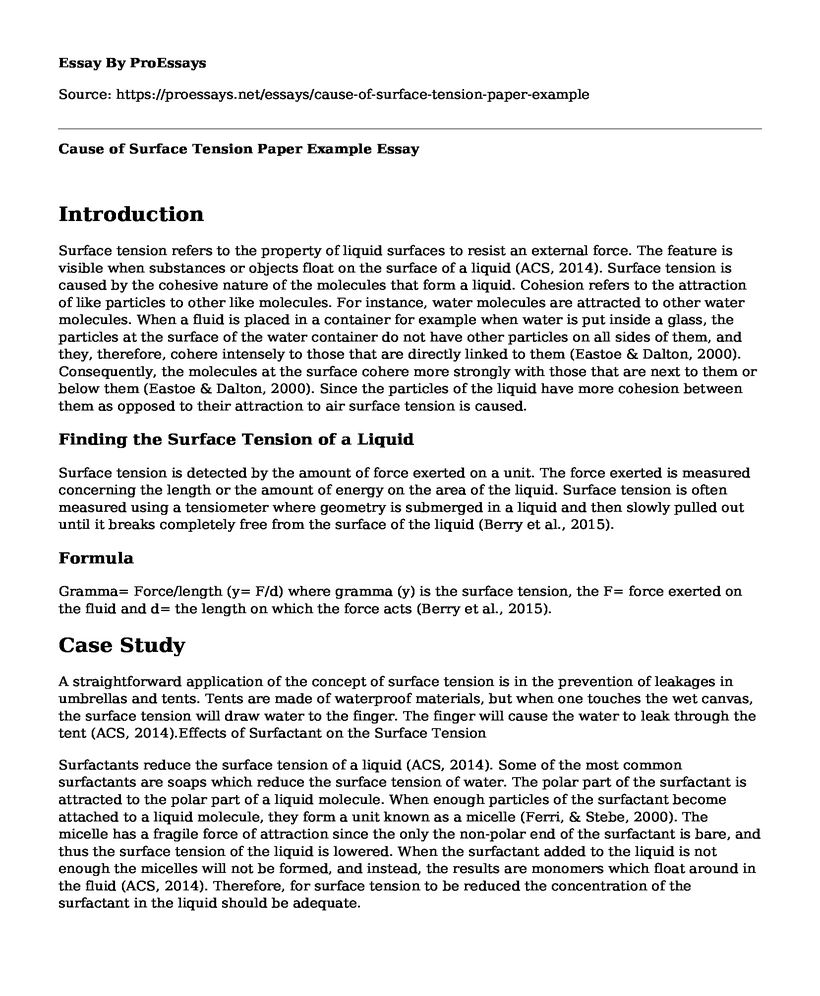Introduction
Surface tension refers to the property of liquid surfaces to resist an external force. The feature is visible when substances or objects float on the surface of a liquid (ACS, 2014). Surface tension is caused by the cohesive nature of the molecules that form a liquid. Cohesion refers to the attraction of like particles to other like molecules. For instance, water molecules are attracted to other water molecules. When a fluid is placed in a container for example when water is put inside a glass, the particles at the surface of the water container do not have other particles on all sides of them, and they, therefore, cohere intensely to those that are directly linked to them (Eastoe & Dalton, 2000). Consequently, the molecules at the surface cohere more strongly with those that are next to them or below them (Eastoe & Dalton, 2000). Since the particles of the liquid have more cohesion between them as opposed to their attraction to air surface tension is caused.
Finding the Surface Tension of a Liquid
Surface tension is detected by the amount of force exerted on a unit. The force exerted is measured concerning the length or the amount of energy on the area of the liquid. Surface tension is often measured using a tensiometer where geometry is submerged in a liquid and then slowly pulled out until it breaks completely free from the surface of the liquid (Berry et al., 2015).
Formula
Gramma= Force/length (y= F/d) where gramma (y) is the surface tension, the F= force exerted on the fluid and d= the length on which the force acts (Berry et al., 2015).
Case Study
A straightforward application of the concept of surface tension is in the prevention of leakages in umbrellas and tents. Tents are made of waterproof materials, but when one touches the wet canvas, the surface tension will draw water to the finger. The finger will cause the water to leak through the tent (ACS, 2014).Effects of Surfactant on the Surface Tension
Surfactants reduce the surface tension of a liquid (ACS, 2014). Some of the most common surfactants are soaps which reduce the surface tension of water. The polar part of the surfactant is attracted to the polar part of a liquid molecule. When enough particles of the surfactant become attached to a liquid molecule, they form a unit known as a micelle (Ferri, & Stebe, 2000). The micelle has a fragile force of attraction since the only the non-polar end of the surfactant is bare, and thus the surface tension of the liquid is lowered. When the surfactant added to the liquid is not enough the micelles will not be formed, and instead, the results are monomers which float around in the fluid (ACS, 2014). Therefore, for surface tension to be reduced the concentration of the surfactant in the liquid should be adequate.
Colloids and Dispersions
Colloids are mixtures where one substance which contains microscopically dispersed soluble particles is suspended in another element (Nelson, 2002). The dispersed element is then referred to as a colloid. The small size of the articles leads to materials that do not sediment in normal conditions. Dispersions, on the other hand, refer to a mixture where discrete particles of one element are dispersed in a continuous phase of another substance. Colloidal dispersions refer to a combination of various forms of matter (Helenius & Simons, 1975). When the different types of matter are mixed, they do not separate but form colloidal dispersions, for instance, gelatin protein in water. The equation associated with colloids and dispersions is the Stokes law which is dx/dt=d2 (rho1-rho2) g/18viscosity.
References
ACS. (2014). Celebrating chemistry. American chemical society. Retrieve from: https://www.acs.org/content/dam/acsorg/education/outreach/cced/CCED-2014-Celebrating-Chemistry-English.pdf
Berry, J. D., Neeson, M. J., Dagastine, R. R., Chan, D. Y., & Tabor, R. F. (2015). Measurement of surface and interfacial tension using pendant drop tensiometry. Journal of colloid and interface science, 454, 226-237.
Eastoe, J., & Dalton, J. S. (2000). Dynamic surface tension and adsorption mechanisms of surfactants at the air-water interface. Advances in colloid and interface science, 85(2-3), 103-144.
Ferri, J. K., & Stebe, K. J. (2000). Which surfactants reduce surface tension faster? A scaling argument for diffusion-controlled adsorption. Advances in colloid and interface science, 85(1), 61-97.
Helenius, A., & Simons, K. A. I. (1975). Solubilization of membranes by detergents. Biochimica et Biophysica Acta (BBA)-Reviews on Biomembranes, 415(1), 29-79.
Nelson, D. R. (2002). Toward a tetravalent chemistry of colloids. Nano Letters, 2(10), 1125-1129.
Cite this page
Cause of Surface Tension Paper Example. (2022, Aug 01). Retrieved from https://proessays.net/essays/cause-of-surface-tension-paper-example
If you are the original author of this essay and no longer wish to have it published on the ProEssays website, please click below to request its removal:
- History Essay Example on Cuban Revolution
- Microeconomics Issues and Their Effect on US Agricultural Industry - Case Study Sample
- Paper Example on Physical and Chemical Weathering
- Hair Strength and pH Level of Shampoo Essay
- Paper Example on Overcoming Math Anxiety: Cognitive, Affective & Working Memory Models
- Pre-Service Teacher Mathematics: Enhancing Learning, Engagement & Knowledge - Essay Sample
- Essay Example on Tbilisi: The City of Mountains, River and Silk Road







